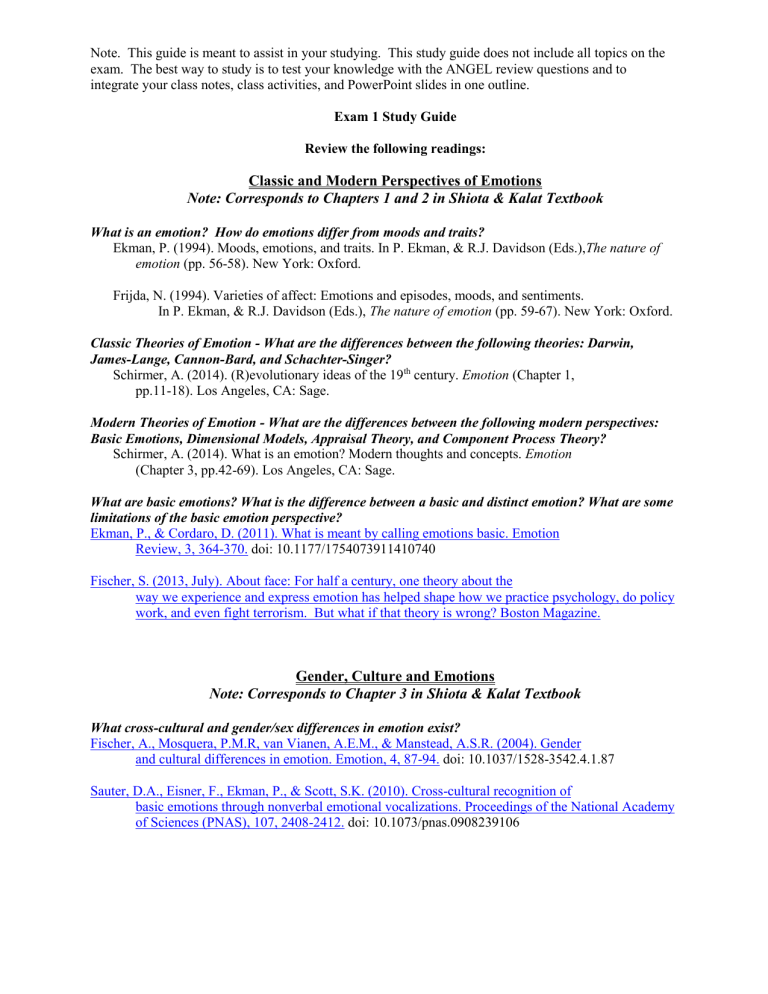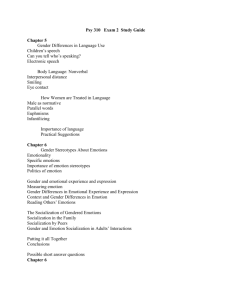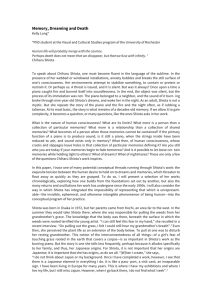Exam 1 Study Guide

Note. This guide is meant to assist in your studying. This study guide does not include all topics on the exam. The best way to study is to test your knowledge with the ANGEL review questions and to integrate your class notes, class activities, and PowerPoint slides in one outline.
Exam 1 Study Guide
Review the following readings:
Classic and Modern Perspectives of Emotions
Note: Corresponds to Chapters 1 and 2 in Shiota & Kalat Textbook
What is an emotion? How do emotions differ from moods and traits?
Ekman, P. (1994). Moods, emotions, and traits. In P. Ekman, & R.J. Davidson (Eds.), The nature of emotion (pp. 56-58). New York: Oxford.
Frijda, N. (1994). Varieties of affect: Emotions and episodes, moods, and sentiments.
In P. Ekman, & R.J. Davidson (Eds.), The nature of emotion (pp. 59-67). New York: Oxford.
Classic Theories of Emotion - What are the differences between the following theories: Darwin,
James-Lange, Cannon-Bard, and Schachter-Singer?
Schirmer, A. (2014). (R)evolutionary ideas of the 19 th century. Emotion (Chapter 1, pp.11-18). Los Angeles, CA: Sage.
Modern Theories of Emotion - What are the differences between the following modern perspectives:
Basic Emotions, Dimensional Models, Appraisal Theory, and Component Process Theory?
Schirmer, A. (2014). What is an emotion? Modern thoughts and concepts. Emotion
(Chapter 3, pp.42-69). Los Angeles, CA: Sage.
What are basic emotions? What is the difference between a basic and distinct emotion? What are some limitations of the basic emotion perspective?
Ekman, P., & Cordaro, D. (2011). What is meant by calling emotions basic. Emotion
Review, 3, 364-370.
doi: 10.1177/1754073911410740
Fischer, S. (2013, July). About face: For half a century, one theory about the way we experience and express emotion has helped shape how we practice psychology, do policy work, and even fight terrorism. But what if that theory is wrong? Boston Magazine.
Gender, Culture and Emotions
Note: Corresponds to Chapter 3 in Shiota & Kalat Textbook
What cross-cultural and gender/sex differences in emotion exist?
Fischer, A., Mosquera, P.M.R, van Vianen, A.E.M., & Manstead, A.S.R. (2004). Gender and cultural differences in emotion. Emotion, 4, 87-94.
doi: 10.1037/1528-3542.4.1.87
Sauter, D.A., Eisner, F., Ekman, P., & Scott, S.K. (2010). Cross-cultural recognition of basic emotions through nonverbal emotional vocalizations. Proceedings of the National Academy of Sciences (PNAS), 107, 2408-2412.
doi: 10.1073/pnas.0908239106
Note. This guide is meant to assist in your studying. This study guide does not include all topics on the exam. The best way to study is to test your knowledge with the ANGEL review questions and to integrate your class notes, class activities, and PowerPoint slides in one outline.
Concept
Classic Theories and Modern Perspectives
Definition of Emotion/Components of Emotion
Basic Emotions Theory/Ekman
Evolutionary Theory
Schachter-Singer, James-Lange, Cannon-Bard
Dimensional Models
Cognitive Appraisal Theory
Social Constructivist Theory/Lisa Barrett
Prototype Approach
Culture and Gender
Definition of Culture / Ways to Measure Culture
Research on Cultural Differences in Emotions
Gender and Culture
Approximate Number of Questions
2
1
5
2
6
3
6
9
8
2
6









